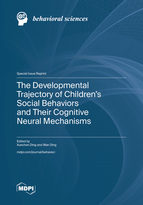The Developmental Trajectory of Children's Social Behaviors and Their Cognitive Neural Mechanisms
A special issue of Behavioral Sciences (ISSN 2076-328X). This special issue belongs to the section "Developmental Psychology".
Deadline for manuscript submissions: closed (31 July 2023) | Viewed by 28132
Special Issue Editors
Interests: social behavior; peer relationship; socioemotional adjustment
Special Issues, Collections and Topics in MDPI journals
Interests: parenting and child mental health
Special Issues, Collections and Topics in MDPI journals
Special Issue Information
Dear Colleagues,
Normative development of children’s social, emotional, and school adjustment stems from sources including both family and peer groups. Parent–child and peer interactions have unique and significant implications for children, and these social relationships serve as a foundation for feelings of security and belonging. During the socialization process in family and school contexts, children display a wide variety of social behaviors, including aggressive behavior, social withdrawal, prosocial behavior, antisocial behavior, cooperative behavior, bullying behavior, etc. However, several issues require further exploration. For example, what are the different causal relations that might underlie children’s social behaviors? What is the trajectory of these social behaviors at different developmental stages? Could we find a more neural basis for these social behaviors via advanced techniques (e.g., EEG, ERP, fNIRS, fMRI)? In light of these premises, this Special Issue aims to advance the literature on the development trajectory of children’s social behaviors and their cognitive neural mechanisms. We therefore call for papers on empirical research that focuses on predictors and outcomes of children’s social behaviors in family and school contexts from early childhood to emerging adulthood, risk/protective factors among these associations, social behaviors in different contexts, or their cognitive neural mechanisms. Longitudinal design is especially encouraged. Cross-sectional designs that focuses on age differences, meta-analysis, and systematic review are also welcome.
Dr. Xuechen Ding
Dr. Wan Ding
Guest Editors
Manuscript Submission Information
Manuscripts should be submitted online at www.mdpi.com by registering and logging in to this website. Once you are registered, click here to go to the submission form. Manuscripts can be submitted until the deadline. All submissions that pass pre-check are peer-reviewed. Accepted papers will be published continuously in the journal (as soon as accepted) and will be listed together on the special issue website. Research articles, review articles as well as short communications are invited. For planned papers, a title and short abstract (about 100 words) can be sent to the Editorial Office for announcement on this website.
Submitted manuscripts should not have been published previously, nor be under consideration for publication elsewhere (except conference proceedings papers). All manuscripts are thoroughly refereed through a single-blind peer-review process. A guide for authors and other relevant information for submission of manuscripts is available on the Instructions for Authors page. Behavioral Sciences is an international peer-reviewed open access monthly journal published by MDPI.
Please visit the Instructions for Authors page before submitting a manuscript. The Article Processing Charge (APC) for publication in this open access journal is 2200 CHF (Swiss Francs). Submitted papers should be well formatted and use good English. Authors may use MDPI's English editing service prior to publication or during author revisions.
Keywords
- social behavior
- social withdrawal
- aggressive behavior
- prosocial behavior
- antisocial behavior
- parent–child interaction
- parenting
- neuroscience
- ERP
- fMRI
- fNIRS







